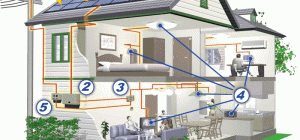 The fluorescent fixture is one of the traditional lighting options with multiple applications in warehouses, commercial spaces, outdoor and general room lighting.
The fluorescent fixture is one of the traditional lighting options with multiple applications in warehouses, commercial spaces, outdoor and general room lighting.
These days, however, out of more advanced lighting fixtures, fluorescent lamps seem to have some disadvantages. For instance, low-temperature sensitivity, relatively high in price, even higher energy consumption, susceptibility to chemical leakage-dimming-degradation etc. are some major problems that should make you think twice while looking for the right lighting fixture for your space.
Light-emitting diode or LED tube lights can be a great upgraded alternative to florescent lamps in many ways. Here are some of the reasons why you should consider upgrading your fluorescent lamps with LED light fixtures.
1. Lighting performance
- CRI or theColor Rendering Index is the scale from 0 to 100% to measure the accuracy of the given light source at rendering. Fluorescent lights have CRI of about 63, whereas LEDs have much improved CRI of 80. Which means, LED tube lights and battens have better color rendering and correlated color temperature.
- Because of LEDs’ broad range of color temperature, LED lamps to increase the visual perception of natural brightness, compared to conventional fluorescent lights. Fluorescent tube lights commonly appear to be bluish, and LEDs lights appear to be naturally white. The subjects under LED lights are very close to natural light emissions are very close to natural lights like it is during the day.
- Fluorescent lights perform the best only in room temperature. The efficiency of its lighting performance decreases when the temperature is lower. LED tube lights perform significantly well in cold temperature. Since t8 LED tubes are made using plastic, they’re more adaptable in sudden temperature changes.
2. Longer lifespan
- Fluorescent lights have a typical lifespan of around 7,000-15,000 hours. T8 LED tubes, LED battens, on the other hand,can produce 100,000 hours of use, which is 100 times more than any typical incandescent or fluorescent bulbs.
- Fluorescent lamps require re-lamping and ballast replacement during its general life expectancy. LED tubes work efficiently with a little or no maintenance over a lifetime! If the LED lights are used 10 hours a day, it may exceed its lifespan for over 13.7 years.
- The lifespan of fluorescent lights can decrease significantly by repetitive turn on and off. LED battens are way less affected by the repetitive on-off cycle.
3. Energy efficiency
- Fluorescent lights have system efficiency, much lower than 30lumens/watt. Compared to that, LED tube lights are highly efficient with the mill source proficiency from 37 to 135 lumens/watt.
- In traditional fluorescent lightings, 80% of electric energy is wasted because of the heat generation, resulting in only 20% energy efficiency that converts to light energy. LED lights, on the contrary, generates 27% more light per tube and 40% energy reduction compared to fluorescent lights. Large site projects backed with LED lighting result in 60-75% energy reduction and overall energy efficiency, compared to fluorescents.
- Fluorescents emit the light in a 360° beam, in other words- omnidirectional directional. For display lighting, task lighting, etc., omnidirectional fluorescent fixtures are not the most practical choice. 30% of the light lumens in this way gets trapped LEDs in comparison emit the light in a 120° degree beam outwardly, which means less to no scattered light.
4. Environmental safety
- Fluorescent strip lights or lamps contain harmful chemicals like mercury which can be released as both dust and vapor if the light is broken. The toxicity of mercury moves up through the food chain directly. On top of that, the disposal of fluorescent lights in the landfill can be contaminating.
- Unlike fluorescent lamps, LEDs do not contain any harmful or toxic chemicals. On top of that, LED tube lights can also be recycled even after its lifespan. So switching to LED spares you the cost and time required for complicated disposal and keeps the environment safe from toxic waste.
5. Initial cost and other factors
- Compared to traditional incandescent bulbs, both fluorescent and LED tube lights cost more. Even though LED lamps cost more than fluorescent lighting initially, it saves up a lot of money later on by reducing energy consumption, lowering your utility bills and cutting down on bulb replacements.
- On top of that, the initial cost of t8 LED tubes and LED battens have gone down considerably in the past couple of years. LED tube lights do not have a filament, so they are more durable with 10 times more life expectancy than the compact fluorescents
- The longer fluorescent bulbs are used, the more likely the chemical properties of the fixtures shift to cause an imbalanced reaction. The fluorescence becomes dimmer over time, which can potentially cost you to constant squint, high glare or event trigger migraine attacks due the dimmed yet harsh lights. LED lights, on the contrary, do not generate near-infrared radiation- so it’s more comfortable for eyes.
LED has been becoming the required lighting solution in Australia both for residences and businesses, which accounts for 10% of the average household utility budget and 18-40% of in commercial premises. Hence, upgrading your fluorescents with LEDs is not just a choice for you; it’s essentiality.








I didn’t know the working of these lamp that i use everyday and now i know more than that thank you for this Info.